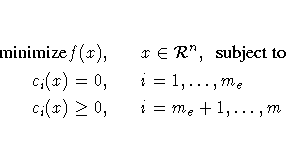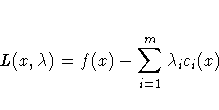Chapter Contents
Previous
Next
|
Chapter Contents |
Previous |
Next |
| Nonlinear Optimization Examples |


If the functions f and ci are twice differentiable, the
point x* is an isolated local minimizer of the NLP
problem, if there exists a vector ![]() that meets the following conditions:
that meets the following conditions:

Each nonzero vector ![]() with
with


In practice, you cannot expect that the constraint functions ci(x*) will vanish within machine precision, and determining the set of active constraints at the solution x* may not be simple.
|
Chapter Contents |
Previous |
Next |
Top |
Copyright © 1999 by SAS Institute Inc., Cary, NC, USA. All rights reserved.